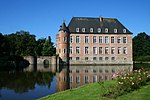Castle of Freÿr
| Castle of Freÿr | |
|---|---|
15th Century | |
| Built by | Guillaume de Beaufort-Spontin |
The Castle of Freÿr (
The castle
Dating back to the
Outside
The keep was destroyed in 1554 by the French during the wars against Emperor Charles V. The oldest part of the current castle, the east wing, was built in 1571 and is one of the first examples of the "Renaissance Mosane" style.
During the 17th century the house was enlarged by the addition of three wings, forming a square with the original wing.
Around 1760 the south wing was pulled down and replaced by a
Inside
The castle is representative of the interior of a nobleman's summer residence of the 18th century. It features many original elements such as the impressive main hall with wall paintings by Frans Snyders and a ceiling covered by Louis XV frescoes, or the chapel with its Regency wooden panelling and its Baroque altar.
The rooms contain the ancient furniture of the Dukes of
At Freÿr the Coffee Treaty or Treaty of Freÿr (1675) between France and Spain was signed, and the Treaty of the Borders between France and the Prince-Bishopric of Liège (1772) was negotiated. In the room where the treaty was signed, first time in Belgium was served coffee. At this time Louis XIV stayed here as the guest of Jeanne d'Harscamp, Dowager Duchess of Beaufort-Spontin.

The gardens

Designed in the style of
Ponds and fountains babble on the lower level where
The upper level is covered by
At the very top of the gardens, the Rococo pavilion commands the view on the Meuse and seduces by its delicate stucco decoration, based on the theme of fertility with cornucopia and Tritons.
The right bank of the Meuse is dominated by Rocks at Freyr more than 100 m high, 340 million years old), from which one has an exceptional view of the estate.
Cooperation
 Marksburg, Germany
Marksburg, Germany Oron Castle, Switzerland
Oron Castle, Switzerland- Villa Rotonda, Italy
- Modave Castle, Belgium
 Ammersoyen Castle, Netherlands
Ammersoyen Castle, Netherlands Château de la Roche Courbon, France
Château de la Roche Courbon, France- Eggenberg Palace, Austria
 Nowy Wiśnicz Castle, Poland
Nowy Wiśnicz Castle, Poland- Luxemburg
Gallery
-
Façade of the castle
-
The Gardens, seen from the other side of the Meuse
-
Fountain in the garden
-
Southern orangerie
-
This terracotta fertility goddess is a reminder ofFreya, twin-sister of Freyr
See also
- Freyr for the Nordic fertility god
- Freyathe twin-sister of Frey(r)s
- List of castles in Belgium
- List of protected heritage sites in Hastière








